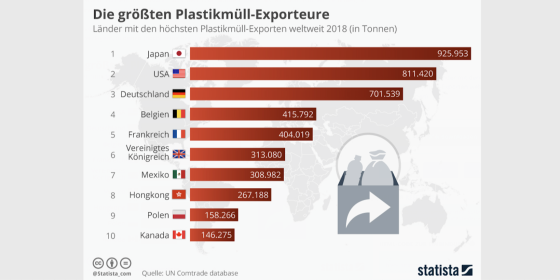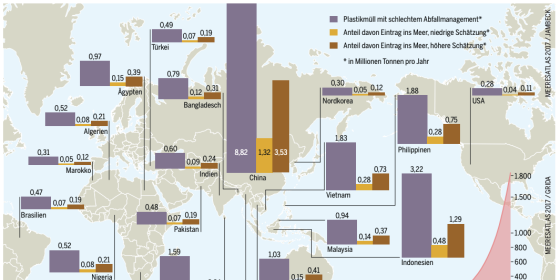END PLASTIC SOUP
Which economies produce plastic, and for what purpose?
The vast majority of plastic production comes from Asian countries, particularly China, closely followed by Europe and North America. In 2020, plastic manufacturing consumed approximately 14% of the oil produced. Depending on the source, this was used to produce about 36-42% for single-use packaging and around 14% for textiles. Another 16-19% went into construction materials, 10-12% into consumer goods, 6-8% into transportation and vehicles, 4-5% into electronics, and approximately 1% into industrial machinery.
Quelle: careelite.de, plastic-footprint.de
How much plastic waste is generated annually and what is it composed of?
European leader in plastic waste generation is Luxembourg with >50kg per capita per year, followed by Ireland (>46kg) and Estonia (>42kg). Concurrently with general waste production, the proportion of plastic waste increases with the prosperity of a society. During the last International Coastal Cleanup in 2018, a large beach cleaning operation in 122 countries, it was evident that the 10 most common types of litter entering the sea all consist at least partially of plastic:
- Cigarette butts
- Food packaging
- Plastic straws and stirrers
- Plastic cutlery
- Plastic bottles
- Bottle caps
- Plastic shopping bags
- Other plastic bags
- Plastic lids
- Plastic cups and plates
Quelle: oceanconcervacy.org
What do countries do with their plastic waste?
Plastic waste is rarely separated and is often found unsorted in residual waste.
In Switzerland, despite a well-functioning system for separation and recycling, 50% of all municipal waste ends up in an incineration plant, with a significant portion being plastic. The actual recycling rate for plastic is only 12-15%. The exact definition of "recycling rate" is not always clear. Switzerland exports approximately 100,000 tons of plastic intended for recycling abroad each year, primarily to Germany. What happens to it there often escapes our control.Source: plastik-recykling.ch, NZZ, oceancare.org)
In general, it can be said that countries with high living standards export the most waste.

For decades, primarily Asian countries have been the main buyers of waste. However, in recent times, these countries have started to push back against the import of waste from industrialized nations. The exports of waste from Europe and the strain on authorities in the recipient countries have led to instances where plastic waste, contrary to agreements, has been dumped, carried away by wind and rain, and eventually transported by Asian rivers into adjacent oceans. 82% of the plastic waste floating in the world's oceans originates from the five countries of China, Thailand, Indonesia, India, and Vietnam.
Source: de.statista.com, careelite.de

Source: meeresatlas.org
So are governments to blame for shipping plastic waste around the globe?
Partly, yes. "Out of sight, out of mind" may have been the motto for many countries for a long time. However, awareness of waste streams and the associated problems is growing worldwide, and there are indeed governments that have been working for several years to address the issue. Since January 1, 2021, stricter rules for the export of plastic waste apply in the European Union. Only clean, separated material that can be easily recycled is allowed to be exported.
Source: bmu.de
Unfortunately, the problem extends beyond that. Plastic pollution in the environment goes far beyond just the large garbage patches in the oceans. Even here in Switzerland, plastic waste can be found in mountain streams, forest soils, and the stomachs of animals. (See also the article about our former Mare Nostrum board member Anna Sidonia Marugg and her scientific work on this topic.)
It is up to each and every one of us to question our personal plastic consumption. Do I even know which everyday products contain primary microplastics? Who thinks about environmental issues when using glitter in children's makeup or a facial scrub? And am I aware that even a fleece jacket worn for years can be problematic because it releases fiber abrasion into the water with every wash?
There are many ways to reduce plastic waste in the environment. At the forefront of waste reduction is certainly waste prevention. However, once the damage is done, as we can see with the pollution of the seas, cleanup is also a viable option. Mare Nostrum has made this one of its goals.
Therefore, visit our projects to see the efforts we support and to witness our impact firsthand.